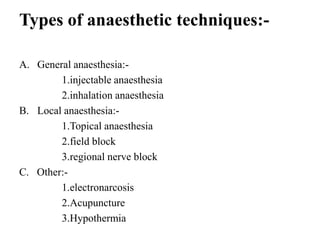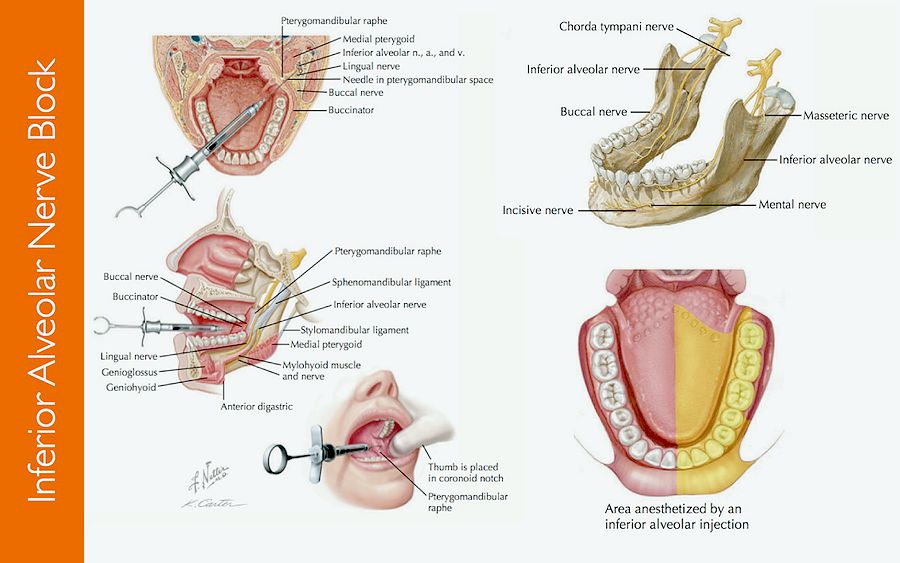Regional Anesthesia
Mastering Anesthesia Techniques: Ensuring Comfort and Safety
![]()
Mastering Anesthesia Techniques: Ensuring Comfort and Safety
Anesthesia techniques are integral to modern medical procedures, ensuring patients experience comfort and safety during surgery or other interventions. This article delves into the diverse realm of anesthesia techniques, highlighting their significance in the healthcare landscape.
The Art and Science of Anesthesia
Anesthesia is both an art and a science. Anesthesia techniques involve the administration of drugs to induce a state of controlled unconsciousness, pain relief, and muscle relaxation. Anesthesiologists, the specialists in this field, meticulously tailor their approach to each patient and procedure, considering factors such as the patient’s medical history, the type of surgery, and the desired depth of anesthesia.
General Anesthesia: Inducing Controlled Unconsciousness
General anesthesia is perhaps the most well-known form of anesthesia. It involves administering medications to induce a state of unconsciousness, allowing patients to remain completely unaware and pain-free during surgical procedures. Anesthesiologists closely monitor vital signs and adjust the anesthesia depth throughout the surgery to ensure the patient’s safety and comfort.
Regional Anesthesia: Targeted Pain Relief
Regional anesthesia targets specific regions of the body, providing pain relief while the patient remains conscious. Techniques like epidurals and spinal blocks are common in procedures such as childbirth or certain orthopedic surgeries. Regional anesthesia offers the advantage of localized pain control, minimizing the need for general anesthesia and reducing postoperative discomfort.
Local Anesthesia: Precision in Pain Management
Local anesthesia is employed for minor procedures or to numb a specific area of the body. This technique involves injecting anesthetic agents directly into the target area, temporarily blocking sensation. Local anesthesia is commonly used in dermatological procedures, dental work, or minor surgeries, ensuring precision in pain management without affecting the patient’s overall consciousness.
Balancing Depth of Anesthesia: The Role of Monitoring
Achieving the right depth of anesthesia is critical for patient safety. Continuous monitoring of vital signs, including heart rate, blood pressure, and oxygen levels, is an integral part of anesthesia techniques. Modern monitoring technology allows anesthesiologists to make real-time adjustments, ensuring the patient’s physiological parameters remain within safe ranges throughout the procedure.
Emerging Technologies in Anesthesia
Advancements in technology continue to shape anesthesia techniques. From sophisticated monitoring devices to the integration of artificial intelligence, these innovations enhance the precision and safety of administering anesthesia. Anesthesiologists leverage these technologies to tailor their approaches, taking into account individual patient responses and optimizing outcomes.
Pediatric Anesthesia: Special Considerations for Young Patients
Administering anesthesia to pediatric patients requires specialized expertise. Pediatric anesthesia techniques consider the unique physiological and developmental characteristics of children. Anesthesiologists carefully calculate drug dosages, monitor vital signs, and create an environment that ensures the safety and well-being of the young patient throughout the procedure.
Anesthesia in Ambulatory Settings: Maximizing Efficiency
The evolution of anesthesia techniques has facilitated their application in ambulatory or outpatient settings. Ambulatory anesthesia focuses on minimizing the duration of sedation, allowing patients to recover quickly and return home on the same day. This approach maximizes efficiency while maintaining the highest standards of safety and comfort.
Patient Education and
Innovative Anesthesia Techniques for Safer Surgeries and Recovery

Exploring Modern Anesthesia Techniques for Enhanced Patient Care
Anesthesia plays a crucial role in modern medicine, ensuring that patients undergo surgical procedures with minimal discomfort and risks. Advancements in anesthesia techniques have not only improved the safety of surgeries but also contributed to more efficient recovery processes. Let’s delve into the innovative approaches shaping the landscape of anesthesia.
Precision in Dosage and Administration
One of the significant advancements in anesthesia is the precision achieved in dosage administration. Anesthesiologists now have access to sophisticated monitoring tools and precise delivery systems, allowing them to tailor the dosage to each patient’s unique needs. This precision enhances the safety of anesthesia, reducing the risk of complications during and after surgery.
Regional Anesthesia: Targeting Specific Areas for Pain Relief
Regional anesthesia techniques have gained prominence for their ability to provide targeted pain relief to specific regions of the body. This approach minimizes the need for general anesthesia, reducing the overall impact on the patient’s body. Techniques like epidurals and nerve blocks are commonly employed, not only for surgical procedures but also for postoperative pain management.
Innovative Approaches to General Anesthesia
General anesthesia remains a cornerstone in various surgical interventions, and recent innovations have focused on refining this approach. From advanced inhalation agents to intravenous drugs with rapid onset and offset, these innovations aim to achieve a more controlled and predictable anesthesia experience. Anesthesia providers continuously explore ways to optimize patient safety and comfort.
Enhanced Recovery After Surgery (ERAS) Protocols
Anesthesia is not only about inducing unconsciousness; it is also a key player in the evolving field of Enhanced Recovery After Surgery (ERAS). Collaborating with surgeons and other healthcare professionals, anesthesiologists contribute to the development and implementation of ERAS protocols. These protocols focus on minimizing stress, optimizing nutrition, and promoting early mobility for faster recovery.
Technology Integration for Monitoring and Control
The integration of technology in anesthesia goes beyond precise dosage delivery. Monitoring systems now provide real-time data on vital signs, allowing anesthesiologists to promptly respond to any deviations. Additionally, automated systems assist in the control of anesthesia levels, ensuring a delicate balance between maintaining unconsciousness and minimizing potential side effects.
Pediatric Anesthesia: Ensuring Safety for Young Patients
Anesthesia for pediatric patients requires specialized considerations, and techniques have evolved to address the unique needs of children. From age-appropriate dosage calculations to child-friendly induction methods, pediatric anesthesia aims to provide a safe and comfortable experience for the youngest surgical patients.
Balancing Analgesia and Avoiding Opioids
In the midst of the opioid crisis, anesthesia techniques are adapting to minimize the reliance on opioids for pain management. Multimodal analgesia approaches, combining different medications and interventions, are becoming more prevalent. This shift not only helps in controlling pain effectively but also contributes to reducing the risk of opioid-related complications.
Patient-Centered Care and Informed Decision-Making
Modern anesthesia practices emphasize patient-centered care and informed decision-making. Anesthesiologists engage in thorough preoperative discussions with patients, explaining the anesthesia plan, potential risks, and expected outcomes. This collaborative approach ensures that patients are active participants in
Navigating Anesthesia: Advanced Techniques

Navigating Anesthesia: Advanced Techniques
Anesthesia is a critical component of many medical procedures, ensuring patient comfort and safety. Advancements in anesthesia techniques have revolutionized the field, providing healthcare professionals with a range of options to tailor anesthesia to individual needs. Let’s explore the landscape of anesthesia techniques and their transformative impact on modern healthcare.
Evolution of Anesthesia Techniques
The evolution of anesthesia techniques has been marked by milestones, from the early use of ether and chloroform to the development of modern inhalation and intravenous anesthetics. Technological innovations and a deeper understanding of pharmacology have contributed to the refinement of anesthesia administration, enhancing both efficacy and safety.
Inhalation Anesthetics: Balancing Depth and Precision
Inhalation anesthetics remain a cornerstone of anesthesia techniques. These agents are administered through inhalation, allowing for precise control over the depth of anesthesia. Advancements in inhalation anesthetics include the use of sevoflurane and desflurane, which offer rapid onset and offset of anesthesia, minimizing recovery times for patients.
Intravenous Anesthesia: Swift and Targeted Effects
Intravenous (IV) anesthesia has gained prominence for its swift and targeted effects. Propofol and etomidate are examples of intravenous anesthetics that induce anesthesia rapidly. The ability to titrate IV anesthetics allows anesthesiologists to maintain a specific level of sedation, ensuring patient comfort during various medical procedures.
Regional Anesthesia: Precision and Limited Sensation
Regional anesthesia involves numbing a specific part of the body, providing both pain relief and preserving consciousness. Techniques like epidural and spinal anesthesia are commonly used for surgeries involving the lower abdomen, pelvis, or lower extremities. Regional anesthesia offers the advantage of targeted pain control with reduced systemic effects.
Peripheral Nerve Blocks: Localized Pain Management
Peripheral nerve blocks are a subset of regional anesthesia that involves injecting anesthetic agents near peripheral nerves. This technique is particularly useful for extremity surgeries, providing localized pain management while allowing patients to remain awake and aware during the procedure. Peripheral nerve blocks contribute to enhanced postoperative pain control.
Monitored Anesthesia Care (MAC): Tailored Sedation
Monitored Anesthesia Care (MAC) involves providing sedation while continuously monitoring vital signs. This technique is commonly used for less invasive procedures, allowing patients to be in a state of conscious sedation. MAC offers the advantage of tailoring sedation levels based on the procedure’s complexity and the patient’s comfort.
Total Intravenous Anesthesia (TIVA): Precise Control
Total Intravenous Anesthesia (TIVA) involves administering all anesthetic agents intravenously without the use of inhaled agents. TIVA provides precise control over anesthesia depth and is often preferred for certain surgeries, including those requiring controlled hypotension. The avoidance of inhalation agents may be beneficial for patients with specific respiratory considerations.
Ultrasound-Guided Anesthesia: Enhanced Precision
Advancements in technology have introduced ultrasound-guided anesthesia, enhancing precision in nerve blocks and other regional anesthesia procedures. Ultrasound allows real-time visualization of anatomical structures, enabling anesthesiologists to target nerves more accurately and reduce the risk of complications.
Enhanced Recovery After Surgery (ERAS): Integrating Anesthesia Techniques
Anesthesia techniques play a vital role in the Enhanced Recovery After Surgery (ERAS) approach. ERAS focuses on optimizing preoperative, intraoperative, and
Anesthesia Harmony: Optimal Care for Comfort

Anesthesia Harmony: Optimal Care for Comfort
Anesthesia care is a critical component of medical procedures, ensuring patients experience optimal comfort and safety throughout their healthcare journey. From pre-operative assessments to post-anesthesia monitoring, the seamless orchestration of anesthesia care contributes significantly to positive surgical outcomes and patient well-being.
Pre-Operative Assessment: Tailoring Anesthesia Plans
The journey of anesthesia care begins with a thorough pre-operative assessment. Anesthesiologists carefully evaluate patients’ medical history, current health status, and any existing conditions to tailor anesthesia plans accordingly. This personalized approach ensures that the chosen anesthesia technique aligns with the individual’s needs, optimizing the overall care experience.
Patient Education: Fostering Informed Consent
A key aspect of anesthesia care is patient education. Anesthesiologists take the time to explain the chosen anesthesia method, potential side effects, and what to expect during the procedure. This communication fosters informed consent, empowering patients with knowledge and alleviating concerns about the anesthesia process. A well-informed patient is better positioned to actively participate in their care journey.
Intraoperative Management: Ensuring Anesthesia Efficacy
During the actual procedure, the expertise of anesthesiologists shines in the realm of intraoperative management. They carefully administer and monitor anesthesia to ensure its efficacy and safety. Constant vigilance allows for adjustments in dosage or technique, responding to the dynamic nature of surgery and promoting a stable and comfortable intraoperative experience for the patient.
Pain Management: Precision in Analgesia
Anesthesia care extends to effective pain management, both during and after surgery. Anesthesiologists employ precise techniques to control pain, utilizing a combination of general anesthesia, regional anesthesia, or analgesic medications. The goal is to minimize discomfort, enhance recovery, and contribute to an overall positive postoperative experience for the patient.
Post-Anesthesia Care: Monitoring Recovery
The continuum of anesthesia care extends into the post-anesthesia care unit (PACU), where vigilant monitoring ensures a smooth transition from the effects of anesthesia to wakefulness. Anesthesiologists and specialized nurses closely observe patients, addressing any emerging concerns promptly. This phase is crucial in managing the initial stages of recovery and providing immediate support if needed.
Regional Anesthesia: Targeted Pain Relief
In certain cases, regional anesthesia becomes a focal point of anesthesia care. Techniques such as epidurals or nerve blocks target specific regions of the body, providing targeted pain relief without rendering the patient fully unconscious. Regional anesthesia plays a vital role in pain management for various surgical procedures, contributing to a more nuanced and tailored approach.
Pediatric Anesthesia: Tailoring Care for Young Patients
Anesthesia care extends its expertise to pediatric patients, requiring a specialized approach. Pediatric anesthesiologists are adept at tailoring care to the unique needs of children, considering factors such as age, weight, and developmental stage. Their focus is on ensuring safety, comfort, and a positive experience for the young patients undergoing medical procedures.
Collaboration with Surgical Teams: Synergy for Success
The success of anesthesia care is closely intertwined with collaboration among healthcare professionals. Anesthesiologists work in synergy with surgical teams, communicating effectively to coordinate the timing and delivery of anesthesia. This collaborative approach ensures that anesthesia seamlessly aligns

